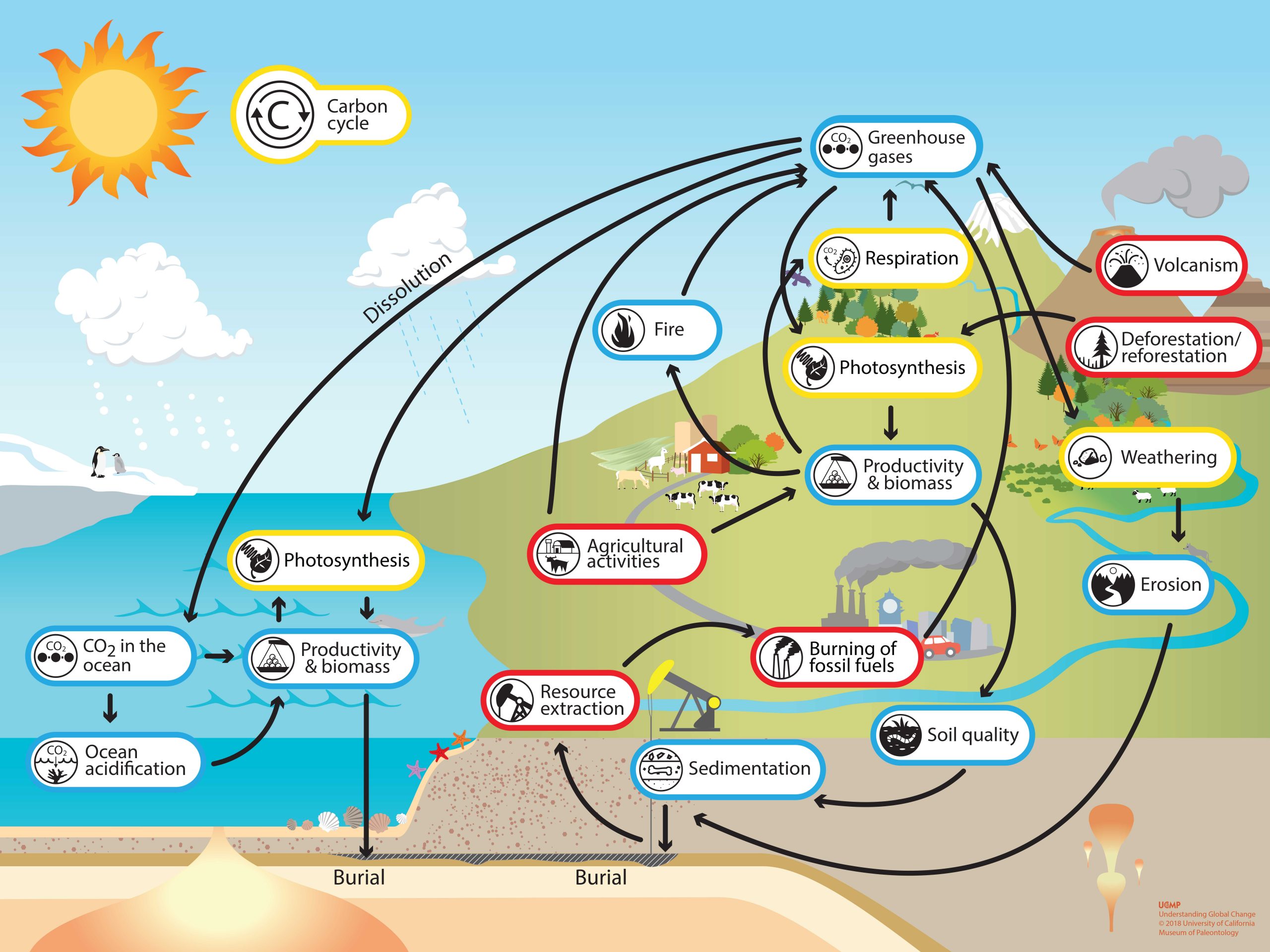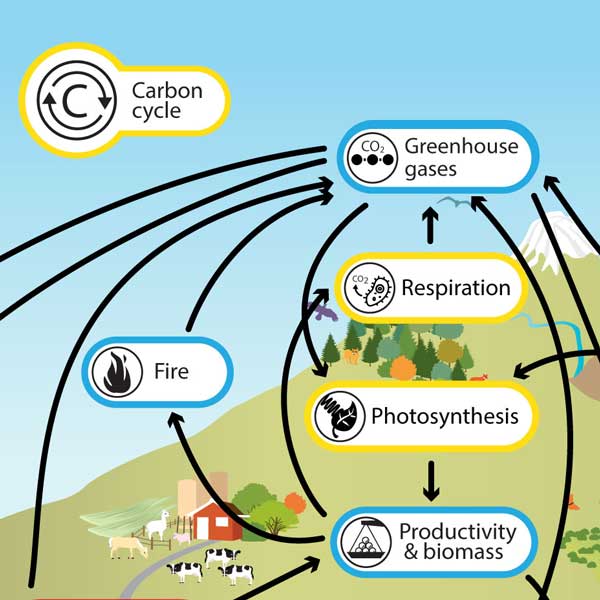While most of the Earth’s carbon can be found in the geosphere, carbon is found in all living things, soils, the ocean, and atmosphere. Carbon is the primary building block of life, including DNA, proteins, sugars and fats. One of the most important carbon compounds in the atmosphere is carbon dioxide (CO2), while in rocks carbon is major component of limestone, coal, oil and gas. Carbon cycles through the atmosphere, biosphere, geosphere, and hydrosphere via processes that include photosynthesis, fire, the burning of fossil fuels, weathering, and volcanism. By understanding how human activities have altered the carbon cycle, we can explain many of the climate and ecosystem changes we are experiencing today, and why this rapid rate of change is largely unprecedented in the Earth’s history.
On this page:
- What is the carbon cycle?
- Earth system model about the carbon cycle
- Explore the Earth System
- Links to Learn More
For the classroom:

Global Change Infographic
The carbon cycle is an essential part of How the Earth System Works. Click the image on the left to open the Understanding Global Change Infographic. Locate the carbon cycle icon and identify other Earth system processes and phenomena that cause changes to, or are affected by, the cycling of carbon.
What is the carbon cycle?
Carbon is transferred between the ocean, atmosphere, soil, and living things over time scales of hours to centuries. For example, photosynthesizing plants on land remove carbon dioxide directly from the atmosphere, and those carbon atoms become part of the structure of the plants. As plants are eaten by herbivores and herbivores are eaten by carnivores, carbon moves up the food web. Meanwhile, the respiration of plants, animals, and microbes returns carbon to the atmosphere as carbon dioxide (CO2). When organisms die and decay carbon also returns to the atmosphere, or is integrated into soil along with some of their waste. The combustion of biomass during wildfires also release large amounts of carbon stored in plants back into the atmosphere.
On longer timescales, significant amounts of carbon are transferred between rocks and the ocean and atmosphere, typically over thousands to millions of years. For example, the weathering of rocks removes carbon dioxide from the atmosphere. The resulting sediments, along with organic material, can be transported (eroded) from the land to enter the ocean where they sink to the bottom. This carbon from land, as well as carbon atoms in CO2 absorbed by the ocean from the atmosphere, can become incorporated into calcium carbonate (CaCO3) shells made by algae, plants, and animals. These shells become buried. As the successive layers of sediment are compressed and cemented they are turned into limestone rock. Over millions of years these carbon-bearing rocks can be exposed to sufficient heat and pressure to melt, causing them to release their carbon back into the atmosphere as carbon dioxide via volcanism. Some of these rocks will also be exposed at the surface of the Earth through mountain building and weathering, and the cycling begins again. Carbon from the mantle (see plate tectonics) is also released into the atmosphere as carbon dioxide through volcanic activity.
Carbon is also transferred to rocks from the biosphere, via the formation of fossil fuels, which form over millions of years. Fossil fuels are derived from the burial of photosynthetic organisms, including plants on land (which primarily forms coal) and plankton in the oceans (which primarily forms oil and natural gas). While buried, this carbon is removed from the carbon cycle for millions of years to hundreds of millions of years.
Human activity, especially the burning of fossil fuels, has dramatically increased the exchange of carbon from the ground back into the atmosphere and oceans. This return of carbon back into atmosphere as carbon dioxide is occurring at a rate that is hundreds to thousands of times faster than it took to bury it, and much faster than it can be removed by the carbon cycle (for example, by weathering). Thus, the carbon dioxide released from the burning of fossil fuels is accumulating in the atmosphere, increasing average temperatures through the greenhouse effect, as well as dissolving in the ocean, causing ocean acidification.

A simplified diagram showing some of the ways carbon dioxide moves through the Earth system, and the overall increase in atmospheric carbon dioxide from 2004-2013.
The rate of exchange and the distribution of carbon in the Earth system is affected by various human activities and environmental phenomena, including:
- The burning of fossil fuels, which rapidly releases carbon dioxide (CO2), a greenhouse gas into the atmosphere, increasing average global temperatures and causing ocean acidification.
- Agricultural activities that release carbon dioxide and methane (CH4, a greenhouse gases) into the atmosphere. For example, methane is produced from the digestion of plant material by cows, and from the bacteria that thrive in rice fields. Carbon dioxide is released from the burning of fossil fuels to power farming equipment, from the mining of minerals and the making of fertilizer. The growing of crops and the raising of livestock also affects local productivity and biomass, and rates of photosynthesis, respiration, and decay of organic material.
- Deforestation, which decreases rates of photosynthesis and thus how much carbon dioxide is captured by the growth of plants. When trees grow they take carbon dioxide out of the atmosphere and transfer it into their wood, leaves, bark and roots. The carbon is returned to the atmosphere when downed trees are left to rot, or if the trees are intentionally set on fire, which is a common means of deforestation. Thus, deforestation typically releases carbon dioxide, unless all the material is used for construction, or for paper products.
- The extent of permafrost (soil that is frozen all year round), which contains methane (CH4, a greenhouse gas). When temperatures remain cold all year-round organic material decays very slowly, and it remains in the soil. The melting of permafrost, which is happening as global temperatures increase, releases methane. The increasing temperatures also increase rates of decay, which further increases the amount of greenhouse gases in the atmosphere.
- Over millions of years changes in the rate of sedimentation and rate of burial of organic matter alters the amount of carbon available for decay and how much carbon is stored in the rock record. For example, increased burial of dead plants and plankton decreases decay thereby increasing the rate of formation of fossil fuels.
- Over millions of years, processes in the rock cycle can change carbon dioxide levels in the atmosphere. For example, the metamorphic reactions that occur under heat and pressure can release carbon dioxide. In contrast, the weathering of rocks that occurs when carbon dioxide dissolves into rainwater to form carbonic acid (H2CO3) reduces the amount of carbon dioxide in the atmosphere. Warming can increase these weathering reactions, but not at a rate that can offset the increase in carbon dioxide due to human activities.
- Geologic changes in the rate of volcanism, driven by plate tectonics, can dramatically alter the amount of carbon dioxide in the atmosphere, but on timescales much longer than human timescales, over millions of years.
Earth system model about the carbon cycle
The Earth system model below includes some of the processes and phenomena related to the carbon cycle. These processes operate at various rates and on different spatial and temporal scales. For example, carbon is transferred among plants and animals over relatively short time periods (hours-weeks), but the human extraction and burning of fossil fuels has altered the carbon cycle over decades. Additionally, processes that include weathering and volcanism affect the carbon cycle over millions of years. Can you think of additional cause and effect relationships between the parts of the carbon cycle and other processes in the Earth system?
Explore the Earth System
Click the bolded terms (e.g. burning of fossil fuels, greenhouse effect, and weathering) on this page to learn more about these process and phenomena. Alternatively, explore the Understanding Global Change Infographic and find new topics that are of interest and/or locally relevant to you.
